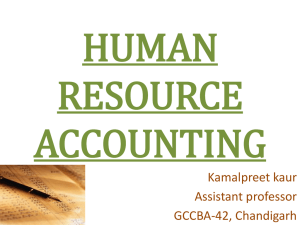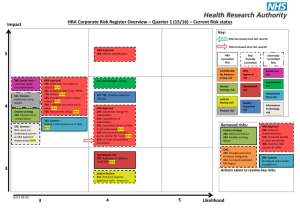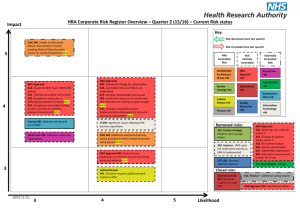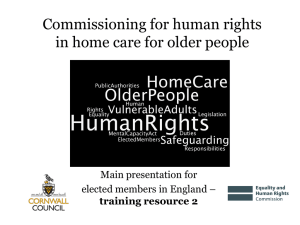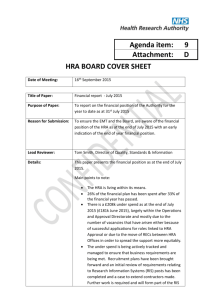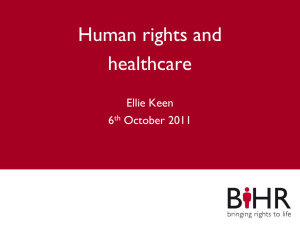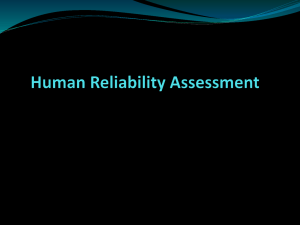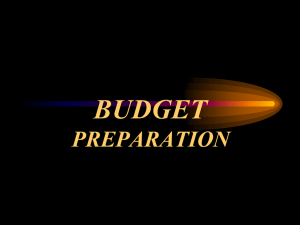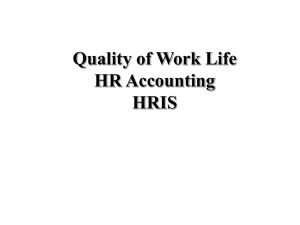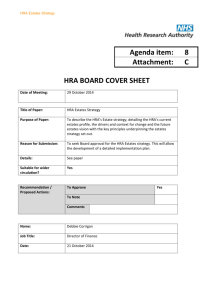Commentary on 1617 HRA Estimates Nov 2015
advertisement
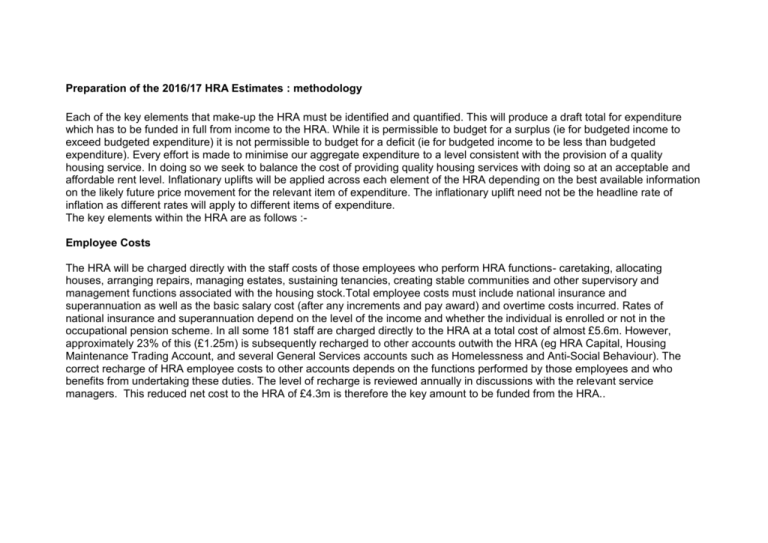
Preparation of the 2016/17 HRA Estimates : methodology Each of the key elements that make-up the HRA must be identified and quantified. This will produce a draft total for expenditure which has to be funded in full from income to the HRA. While it is permissible to budget for a surplus (ie for budgeted income to exceed budgeted expenditure) it is not permissible to budget for a deficit (ie for budgeted income to be less than budgeted expenditure). Every effort is made to minimise our aggregate expenditure to a level consistent with the provision of a quality housing service. In doing so we seek to balance the cost of providing quality housing services with doing so at an acceptable and affordable rent level. Inflationary uplifts will be applied across each element of the HRA depending on the best available information on the likely future price movement for the relevant item of expenditure. The inflationary uplift need not be the headline rate of inflation as different rates will apply to different items of expenditure. The key elements within the HRA are as follows :Employee Costs The HRA will be charged directly with the staff costs of those employees who perform HRA functions- caretaking, allocating houses, arranging repairs, managing estates, sustaining tenancies, creating stable communities and other supervisory and management functions associated with the housing stock.Total employee costs must include national insurance and superannuation as well as the basic salary cost (after any increments and pay award) and overtime costs incurred. Rates of national insurance and superannuation depend on the level of the income and whether the individual is enrolled or not in the occupational pension scheme. In all some 181 staff are charged directly to the HRA at a total cost of almost £5.6m. However, approximately 23% of this (£1.25m) is subsequently recharged to other accounts outwith the HRA (eg HRA Capital, Housing Maintenance Trading Account, and several General Services accounts such as Homelessness and Anti-Social Behaviour). The correct recharge of HRA employee costs to other accounts depends on the functions performed by those employees and who benefits from undertaking these duties. The level of recharge is reviewed annually in discussions with the relevant service managers. This reduced net cost to the HRA of £4.3m is therefore the key amount to be funded from the HRA.. Property Costs It is prudent for the Council to insure its housing stock and the insurance premiums for the mortgaged property blanket insurance, housing properties insurance, public & employer’s liability insurance and engineering inspection charge associated with this stock must be charged to the HRA..The annual cost of this is around £1m. The HRA also has to bear the running costs (rents, rates, electricity, cleaning etc) of the offices from which it operates as well as the cost of providing communal lighting in tenements and multis and communal heating in its sheltered housing units. Estimates for utility prices clearly have to include assumptions about future price movements. Non-insurance property costs ( ie rents, rates, electricity, cleaning, gas etc) are around £0.9m per annum. Transport Costs An inflationary uplift has to be applied to staff travel allowances and vehicle hires. About half of transport costs (£60k) will be attributable to the vans hired within the mobile caretaking service. Supplies & Services and Admin Costs An inflationary uplift has to be applied to postages, tenant participation expenditure (including the provision of accommodation for free to registered tenants and residents groups, IT support and maintenance costs and printing, stationery , telephones etc. associated with running the housing service.These costs can be around £0.380m per annum. Central Support Costs The range of central support services from other Council departments provided to the HRA includes Financial and Legal, Computer Systems, Human Resources, Risk Management, Corporate Communications. The single largest recharge is for rent collection and arrears services. The costs of these services are allocated to the HRA on a time spent basis, with the exception of the office accommodation costs, which are based on occupancy percentages, and the Telephones where the allocation is based on estimated usage. Being predominantly staff costs the estimate for this cost has to reflect changes in employee costs (pay award and national insurance and superannuation changes). Given the number and extent of these services it is not surprising that the cost is around £2m per annum. A breakdown of the 2014/15 central support charge is given below :Rent Collection & Arrears 1,302,103 Finance Audit,Health & Safety, Insurance 318,310 Corporate Communications 63,890 Legal & Regulatory Services 48,064 Procurement 29,049 Human Resources 63,087 Information Technology 210,546 Courier 8,162 16,938 2,060,150 Other Agencies This heading covers legal fees for court actions, rent abatements , bank charges and factor’s fees for HRA shops .Typically around £0.120m per annum each element will be assessed to establish whether an inflationary uplift is appropriate. Strategy and Support Costs Strategy and Support costs include costs of consultancy (e.g. standard delivery plan, housing inspection) , best value memberships, and subscriptions to Housing Bodies such as the Chartered Institute of Housing. Re-allocated Salaries. As mentioned above some 23% of the employee costs of the HRA are subsequently recharged to other accounts outwith the HRA (eg HRA Capital, Housing Maintenance Trading Account, and several General Services accounts such as Homelessness and AntiSocial Behaviour).The appropriate allocations are reviewed annually in accordance with the level of service provided outwith the HRA. Repairs & Maintenance Total repairs expenditure in 2014/15 was £11.170m. and about 46,500 repair lines were issued. This places West Dunbartonshire slightly below the Scottish local authority average for expenditure per house. Total repairs expenditure will be made-up of a number of expenditure lines :Day-to-day repairs (jobbing repairs) Repairs to void houses Disabled adaptations Environmental improvement works Maintenance agreements (gas, ventilation systems, lifts, dry risers etc ) Fire damage repairs Other general repairs (eg decant costs, community alarms) The likely future level of these repair commitments must be established along with an estimate of the likely cost. Bad Debt Provision This is where problems with current tenant arrears, former tenant arrears and irrecoverable debtor accounts will show in the revenue account. The precise impact of recent welfare changes on arrears and level of outstanding debtor accounts remains uncertain, and accordingly the adequacy or otherwise of the budget is similarly uncertain. Budget provision to date has been adequate and the Council continues in its strategy to minimise debt and arrears. However, there has undoubtedly been a steady deterioration in arrears since 2010 and increasing pressure on this budget can be anticipated going forward. Rents – Unlet Period The average number of void houses has to be established. The number implicit in the budget should be both realistic and challenging. It is not unreasonable, given other initiatives, that one should assume that void performance should improve and that the average number of void houses per week in the budget is less than currently observed void levels. The budgeted level of voids will therefore be agreed with the appropriate managers in the service. Loan Charges Loan charges, which reflect the cost of servicing HRA capital borrowing, have increased substantially in recent years . This reflects the high levels of capital expenditure in recent years (£23.3m in 2012/13 , £31.7m in 2013/14 and £35.4m in 2014/15) as movement towards meeting the SHQS progressed and the Council embarked on a programme of building new Council houses. In the past five years capital expenditure has more than doubled. High HRA Capital expenditure will however have to be maintained in the coming years even though the SHQS deadline has passed:i) there is a need to ensure continual compliance with the SHQS and an annual return confirming this will be necessary ii) there is a need to achieve EESSH (energy efficiency standards in social housing) standards in our housing stock and again an annual return setting out progress must be returned to the Government iii) there is our landlord obligation to invest in our stock over and above meeting EESSH standards or maintaining SHQS standards eg new build, structural improvements, protecting our investment etc The loan charges estimate will be based on future planned levels of capital expenditure, expected capital receipts, the average borrowing rate and the projected loan repayment profile. Income Although there are some other income streams to the HRA rental income by far the largest component is rental income from houses (over 90%) :i) Non-rental income is made-up of interest received and factoring/insurance accounts which are recharged to homeowners to reflect the benefit they receive from certain services which are provided by and charged in full to the HRA eg property insurance for mixed tenure dwellings and the provision of communal repair services (eg lift maintenance). This recharge is assessed annually and amended in accordance with the Council decision on the increase for sales, fees and charges. ii) The rental income figure is based on an estimated average housing stock at the mid-year of the year for which the estimate refers multiplied by the current average rent. The estimate for the housing stock must recognise additions to (new build, buy-backs) and removals from ( demolitions ,transfers, Right to Buy) the current stock figure over the coming year or so. The difference between aggregate expenditure and aggregate income is the net expenditure which must be covered either by a rent increase or a reduction in expenditure or a combination of both. As stated previously this is necessary as it is not permitted to budget for a deficit on the HRA.
